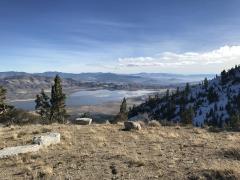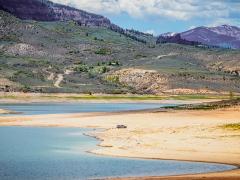Fire Managers Look to Soil Moisture Data to Conduct Safer Prescribed Burns
To understand fire risk and provide warnings for floods, Alabama natural resource managers are looking to data buried in the soil. Data collected from a growing network of soil moisture sensors are helping forest managers in Alabama determine if they can safely conduct prescribed burns and flood managers enhance flood warning systems.
In August 2023, the Alabama Forestry Commission called off a planned prescribed fire at Alabama’s Gulf State Park after soil moisture data and fire models indicated conditions would be too risky to burn as planned. This marks the first time the Forestry Commission had access to real time soil moisture data at a prescribed burn site, said Forestry Commission Fire Analyst Ethan Barrett.
“The soil moisture sensors indicated quickly-drying soils within the prescribed burn area in late July that began to translate to a dropping water table. This provided an early warning for conditions to come,” said Lee Ellenburg, a research engineer at the University of Alabama in Huntsville’s Earth System Science Center and Alabama associate state climatologist. Ellenburg leads the team installing the sensors.
Soil moisture, the water stored between particles of soil, can provide an early warning of conditions to come, signaling the likely onset and severity of drought and flooding. Although drought managers and climatologists agree that such data would be valuable, there are currently not many stations reporting publicly accessible soil moisture data in Alabama, leading to significant gaps in data coverage.
To fill that gap, Ellenberg's team developed a new type of low cost soil moisture monitoring station to deploy across the state.
These stations are being installed as part of a larger regional project to enhance soil moisture monitoring in Alabama, Georgia, and Florida. The project, part of the National Coordinated Soil Moisture Monitoring Network, seeks not only to expand the number of soil moisture monitoring sites in the region, but also to understand how new, more affordable sensors perform compared to existing sensors; improve models of drought indices using soil moisture data; and support public access to real-time soil moisture data. The project is a partnership between the University of Alabama in Huntsville, the University of Georgia, the University of Florida, NOAA’s National Integrated Drought Information System, and NOAA’s Weather Program Office.
Alabama’s growing soil moisture network demonstrates how accessible soil moisture data can support safer, more resilient communities with early warnings of drought, fire, and flood risks.
The data generated from this expanded network is already helping Alabama forest managers make decisions to manage fire risk, and it is expected to support improved flood warnings. For example, using data from sensors in Alabama’s forests, fire managers monitor fire danger to implement burn restrictions and prevent future wildfires. This data also helps fire managers determine when to conduct prescribed burns, which are controlled fires that burn woody debris that could otherwise fuel larger, uncontrolled fires.
Soil moisture observations can forewarn of impending drought or flood conditions before other more standard indicators are triggered. This data is also expected to improve drought and flood forecasts and monitoring. The Choctawhatchee, Pea and Yellow Rivers Water Management Authority plans to use data from the sensors to enhance its Flood Warning System.
These sensors are also part of a broader initiative examining how soil moisture impacts vegetation health. This will help researchers understand how soil moisture affects fire behavior and fire impacts, such as tree deaths and changes in wildlife habitat.
NIDIS and its partners support current efforts to establish the National Coordinated Soil Moisture Monitoring Network (NCSMMN), a multi-agency, multi-institutional initiative to integrate soil moisture data from around the country and to capitalize on its transformative potential for a wide range of applications across sectors of the economy.







